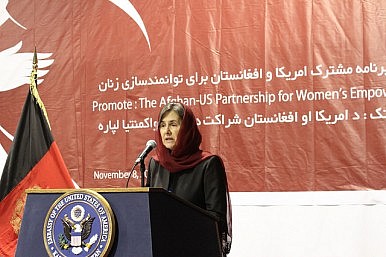By Kyla Ryan
Rula Ghani, wife of recently elected Afghan PresidentAshraf Ghani, has enjoyed a remarkably high profile by the standards of the region. When Ghani delivered his inaugural address he surprised his audience bypublicly addressing his wife, thanking her for her efforts in helping women, children, and the internally displaced persons (IDPs). This was in stark contrast to Ghani’s predecessor, Hamid Karzai, whose wife Dr. Zeenat Quraishi Karzai remained virtually invisible during his long term in office.
The fact that Ghani would publicly thank his wife has sparked hope in some quarters that women might be given a more prominent role in Afghanistan, with positive implications for women’s rights generally. But not everybody was happy: Hard-liners have expressed concern that the foreign-born, Christian first lady could pose a threat to Islamic values.
Rula Ghani was born into a Lebanese Christian family, and is a dual citizen of Lebanon and the U.S. She met her future husband when they were both studying at the American University of Beirut, and the couple lived in Afghanistan for a few years after marrying in 1975. In 1978, Rula and her husband moved to the United States, where he pursued a Ph.D. while she raised their children. The family returned to Afghanistan in 2002, when Ashraf Ghani was appointed finance minister of Afghanistan. Rula was reportedly shocked to see the living conditions many Afghan children were enduring, and went to work for an organization called Aschiana, which helps feed and educate street children.
Rula Ghani has often been compared to Soraya Tarzi, known as Queen Soraya, wife of King Amanullah Khan, who ruled Afghanistan from 1919. The queen – who received an honorary degree from the University of Oxford – was a target for criticism because of her perceived modernity. The queen served as minister of education, and sought to improve the lot of women in society. She established Afghanistan’s first school for girls and its first hospital for women. However, her liberal ideas on women’s roles in society as well as her appearance (including a penchant for short-sleeved dresses) incensed the religious right and was a factor in her ending up in exile with her husband in 1929.
For her part, Rula Ghani has not given any indication of plans to upturn social norms in Afghanistan. Rather, she aims to revolutionize women’s roles within the current structure to improve their quality of life. Ghani has set up an office within the Presidential Palace to find ways to improve conditions for IDPs, who number around 750,000 in Afghanistan. Although women in Afghanistan have won more rights since the fall of the Taliban, they are still heavily restricted by objections to girls receiving an education and working outside the home. Theliteracy rate for females aged 15 to 24 is 32 percent, compared to 62 percent for males. Girls in rural parts of the country are less likely to receive an education. Rula Ghani apparently aims to change this, and encourage Afghans to realize the important roles that women play in society.
However, even during her husband’s campaign her religious and educational background drew criticism. Mohammad Mohaqeq, deputy to the rival presidential candidate Abdullah Abdullah, has commented that Rula was out of touch with Afghan society since she is a foreigner. Her husband was questioned for having a Christian wife. More recently, Rula has been criticized for appearing to side with the French government’s ban on the niqab (face covering). The Presidential Palace of Kabul released a statement insisting that her words were taken out of context.
A first lady who is visible, let alone politically active, is unusual for Afghanistan. Advocating women’s rights backfired for the exiled Queen Soraya. Decades later, Afghanistan is probably still not ready for radical change, but eyes will be on Rula Ghani to see whether she can bring about modest gains in the rights of Afghanistan’s women.

No comments:
Post a Comment